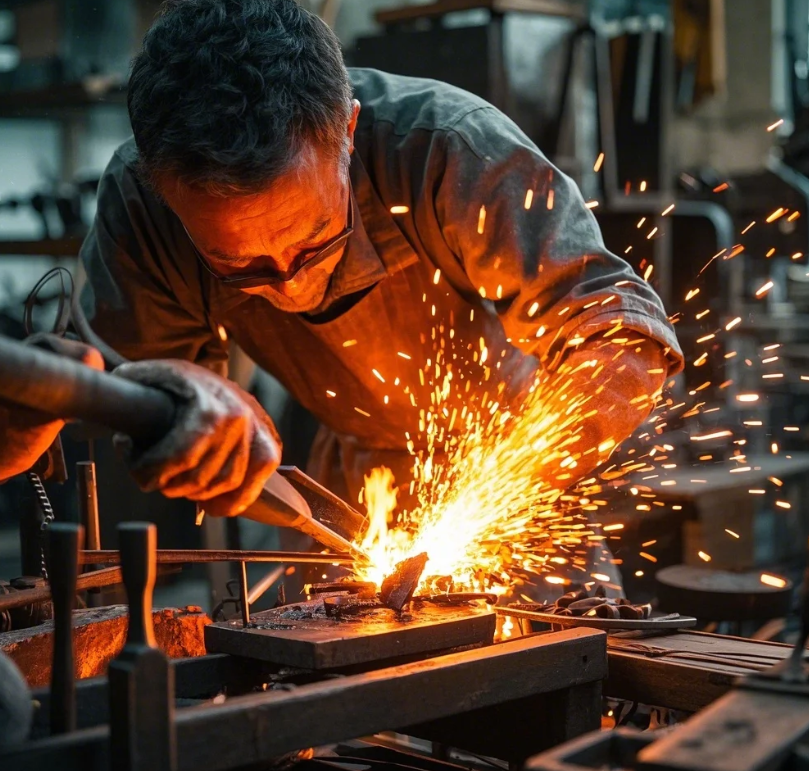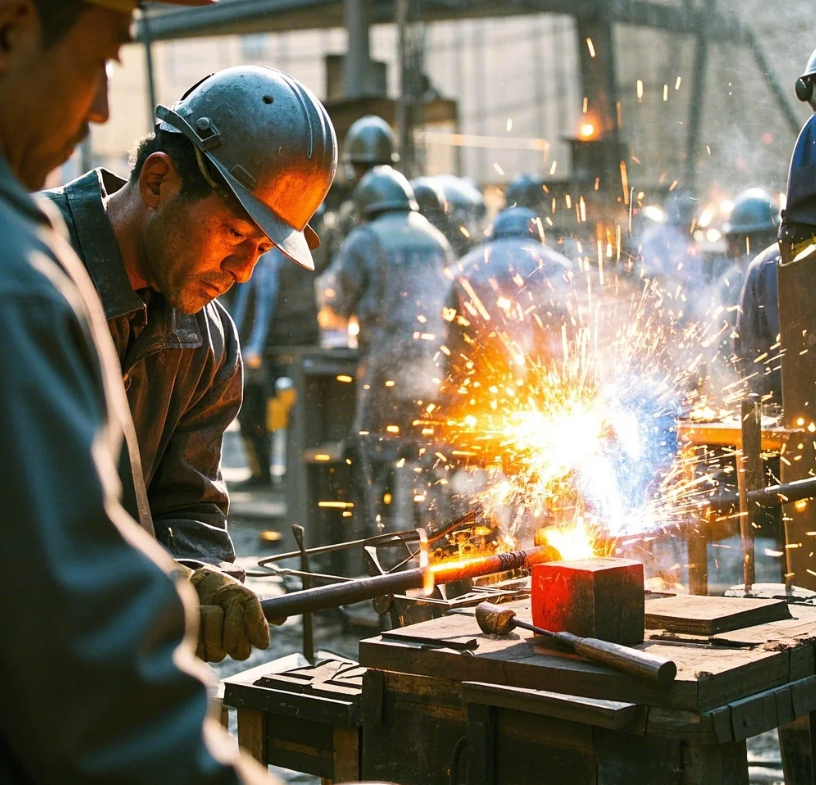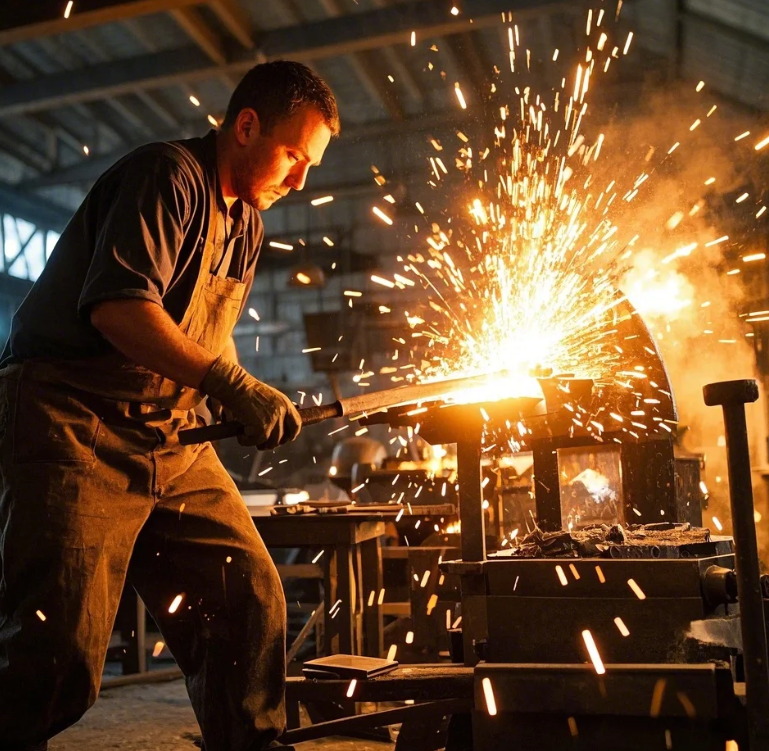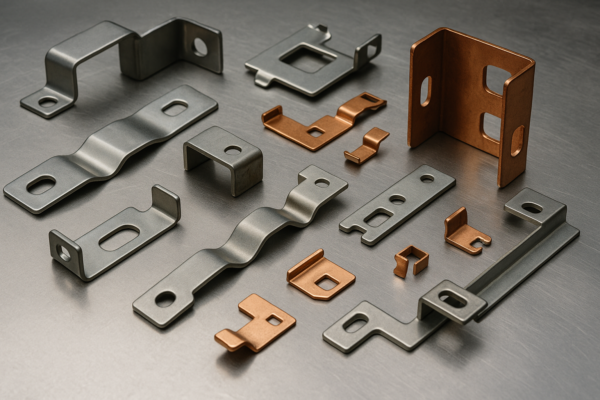Can You Make a Living Blacksmithing?

Many people dream of turning their passion for metalworking into a full-time career. The good news? With the right approach, blacksmithing can absolutely provide a sustainable income.
Professional blacksmiths typically earn $30,000-$80,000 annually by combining custom commissions, teaching workshops, and selling tools/products. Top earners in specialty fields (knifemaking, architectural metalwork) can surpass $100,000 with established reputations.
While challenging, a career in blacksmithing is more viable today than ever before. Let’s examine the realities of making money through this ancient craft.
Can You Make a Living Off Blacksmithing?
Modern blacksmiths have more income opportunities than their medieval predecessors. What was once an essential trade has evolved into a blend of art, craft, and small business.
Yes, skilled blacksmiths can make a full-time living by diversifying income streams. The most successful combine custom work (50-60%), teaching (20-30%), and product sales (10-20%), creating multiple revenue sources that add up to a livable wage.

Key Income Sources for Full-Time Smiths
1. Custom Commission Work
- Examples: Gates, railings, knives, furniture
- Price range: $500-$15,000 per project
- Profit margins: 40-60% after materials
2. Teaching and Workshops
- Going rate: $150-$300 per student per day
- Popular formats: Weekend courses, corporate team-building
- Add-ons: Tool/pattern sales to students
Typical Income Breakdown (Full-Time)
| Income Source | Percentage | Annual Earnings ($60k Goal) |
|---|---|---|
| Custom Work | 55% | $33,000 |
| Workshops | 25% | $15,000 |
| Tool Sales | 15% | $9,000 |
| Other | 5% | $3,000 |
Can You Make a Career Out of Blacksmithing?
Blacksmithing has evolved from an industrial necessity to a respected profession that blends artistry with practical craftsmanship. Those who treat it as a business rather than just a hobby can build lasting careers.
Blacksmithing careers fall into three main categories: production work (30% of professionals), artistic/architectural (45%), and teaching/historical interpretation (25%). Each path requires different skills but offers viable long-term potential with proper business management.

Career Path Options
Production Blacksmithing
- Focus: High-volume, standardized items
- Examples: Hardware, tools, fittings
- Pros: Steady work, wholesale opportunities
Artistic/Architectural Smithing
- Focus: One-of-a-kind commissions
- Clients: Homeowners, businesses, municipalities
- Key skill: Design capability and CAD understanding
Career Longevity Factors
| Factor | Importance | How to Improve |
|---|---|---|
| Business Skills | Critical | Take small business courses |
| Diversification | High | Develop 3+ income streams |
| Networking | High | Join ABANA, attend conferences |
| Physical Health | Moderate | Learn proper body mechanics |
Do Blacksmiths Get Paid Well?
Earnings in blacksmithing vary dramatically based on specialty, location, and business acumen. While not typically a path to great wealth, talented smiths can earn comfortable middle-class incomes.
Successful full-time blacksmiths earn $25-$150 per hour for skilled work, with architectural metalworkers at the higher end ($80-$150/hr) and production smiths at the lower ($25-$50/hr). Income ultimately depends on ability to market high-value skills effectively.

Pay Scale Comparison
Entry-Level (1-3 years experience)
- Hourly Rate: $15-$30
- Annual: $25,000-$45,000
- Typical Work: Assistants, basic production
Mid-Career (5-10 years)
- Hourly Rate: $40-$80
- Annual: $50,000-$90,000
- Specialties: Knives, architectural elements
Master Level (10+ years)
- Hourly Rate: $100-$200
- Annual: $80,000-$150,000+
- Clients: High-end residential, corporate
Geographic Pay Differences
| Region | Avg. Hourly Rate | Notes |
|---|---|---|
| Urban (Coasts) | $75-$125 | Higher cost of living |
| Suburban | $50-$90 | Steady residential work |
| Rural | $35-$65 | Lower overhead costs |
| Tourist Areas | $40-$100 | Seasonal fluctuations |
Can You Be a Blacksmith in Real Life?
The romantic image of the village blacksmith may be outdated, but modern iterations of the craft thrive in surprising ways. Today’s professional smiths combine old-world techniques with contemporary business practices.
Absolutely. Modern blacksmiths work in custom fabrication shops, historical sites, artist studios, and even industrial settings. Many supplement income through online presence (YouTube, Patreon) while maintaining physical workshops for production work.

Real-World Blacksmithing Today
Traditional Smithing
- Locations: Historical villages, museums
- Work: Demonstrations, reproduction pieces
- Income: Often combined with teaching
Contemporary Metal Arts
- Venues: Gallery shows, craft fairs
- Products: Sculptures, designer furniture
- Clients: Art collectors, interior designers
Daily Realities vs. Expectations
| Expectation | Reality |
|---|---|
| Working alone | Often teamwork on big projects |
| All forge work | 30-50% admin/marketing |
| Constant creativity | Many repetitive production jobs |
| Simple tools | Often use power hammers, plasma cutters |
Breaking Into the Field
For those serious about pursuing blacksmithing as a career, certain steps dramatically improve success odds. The path requires equal parts technical skill and business sense.
Aspiring professional blacksmiths should: 1) Complete formal apprenticeship (1-2 years), 2) Develop a signature style/specialty, 3) Build business/marketing skills, and 4) Create multiple income streams before going full-time to ensure stability.

Career Launch Strategies
Education Pathways
- Trade schools: 6 month-1 year programs
- Apprenticeships: 1-3 years with master smith
- Self-taught route: Requires extra hustle
Business Essentials
- Insurance: $600-$2,000 annually
- Licensing: Varies by location
- Bookkeeping: Separate business accounts
First-Year Survival Guide
| Month | Focus Area | Key Tasks |
|---|---|---|
| 1-3 | Skill Building | Take classes, practice fundamentals |
| 4-6 | Small Sales | Sell simple items at markets |
| 7-9 | Portfolio | Document best work professionally |
| 10-12 | Business Setup | Register, get insurance, build website |
Conclusion
Professional blacksmithing remains a viable career for those willing to combine craftsmanship with business savvy. By specializing, diversifying income, and continually improving both technical and entrepreneurial skills, modern smiths can earn $50,000-$100,000 annually doing meaningful, creative work. While challenging, the career offers rare fulfillment for those called to the anvil.







